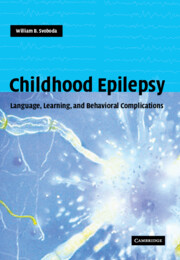Book contents
- Frontmatter
- Contents
- Preface
- Glossary
- 1 Looking ahead
- Part I Speech and language problems
- Part II Learning problems
- 12 Learning challenges
- 13 The development of learning
- 14 Learning difficulties
- 15 Learning problems with seizure types
- 16 Modifying factors
- 17 Transient cognitive impairments of epilepsy
- 18 Attention and alertness
- 19 Memory
- 20 Executive functioning
- 21 Academics
- 22 Antiepileptic medication effects
- 23 Effects of other therapies
- 24 Diagnosis
- 25 Gaining help
- 26 Frustrations of learning problems
- Part III Behavior problems
- Index
- References
20 - Executive functioning
from Part II - Learning problems
Published online by Cambridge University Press: 26 October 2009
- Frontmatter
- Contents
- Preface
- Glossary
- 1 Looking ahead
- Part I Speech and language problems
- Part II Learning problems
- 12 Learning challenges
- 13 The development of learning
- 14 Learning difficulties
- 15 Learning problems with seizure types
- 16 Modifying factors
- 17 Transient cognitive impairments of epilepsy
- 18 Attention and alertness
- 19 Memory
- 20 Executive functioning
- 21 Academics
- 22 Antiepileptic medication effects
- 23 Effects of other therapies
- 24 Diagnosis
- 25 Gaining help
- 26 Frustrations of learning problems
- Part III Behavior problems
- Index
- References
Summary
Executive functioning underlies the development of learning and behavior, yet it is not well understood, especially in children (Eslinger, 1996). Problems such as early-onset epilepsy can inhibit and distort both learning and behavior by impairing brain development, especially frontal lobe function, as well as adversely altering behavioral approaches in raising the child.
Definition
Executive functioning is the ability to decide and act, or to inhibit an action, by developing and applying an appropriate problem-solving approach in order to achieve a future goal (Pennington et al., 1996; Barkley, 1996). This relies on the understanding and use of various styles of thinking, such as planning and self-regulation (Borkowski & Burke, 1996).
When a child is faced by some event in the environment, the first impulse is to respond, often on an emotional basis, which may not prove rewarding. The child needs to be able to pause and consider the options based on remembered previous similar experiences. What is the goal of the response? Is it desirable? The consequences of a response need to be contemplated. The child may need to inhibit a response or defer it to a more appropriate time, when a sequenced plan of action can be developed to gain the desired goal. When the time comes, the child needs to be able to inhibit inferences that detract from the goal decided upon as the act is completed.
- Type
- Chapter
- Information
- Childhood EpilepsyLanguage, Learning and Behavioural Complications, pp. 310 - 319Publisher: Cambridge University PressPrint publication year: 2004



